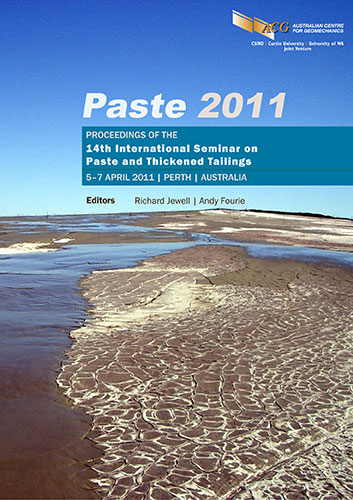Caserones Project – analysis and interpretation of pilot tests’ results

|
Authors: Quelopana, H; Chacón, P; Orellana, R; Barrera, S |
DOI https://doi.org/10.36487/ACG_rep/1104_11_Quelopana
Cite As:
Quelopana, H, Chacón, P, Orellana, R & Barrera, S 2011, 'Caserones Project – analysis and interpretation of pilot tests’ results', in R Jewell & AB Fourie (eds), Paste 2011: Proceedings of the 14th International Seminar on Paste and Thickened Tailings, Australian Centre for Geomechanics, Perth, pp. 111-118, https://doi.org/10.36487/ACG_rep/1104_11_Quelopana
Abstract:
The Caserones Project comprises the exploitation of a copper mine at a rate of 105,000 tpd through the concentration process. In mining processes, concentration usually has the highest fresh water consumption, where much of the water is lost in tailings deposition (evaporation, retention, etc.). This has oriented the efforts to recover as much water as possible from the tailings prior to transportation and deposition. This is why it is imperative to understand the behaviour of this material when it is thickened, or has less water than with the conventional process, in relation to thickening, transport and deposition. This situation is particularly significant in mining located in the North of Chile. Given its location, the Caserones Project, located at the border of the Atacama Desert (an extremely arid region), was faced with a double challenge to be feasible: (i) reduce the consumption of fresh water and (ii) find areas for tailings deposition near the process plant. The solution to this double challenge was possible because of the application of two tailings treatment processes: separation of the total tailings in two materials (sands and slimes) and later thickening of the slimes. The conceptual study was presented in the Paste Seminar 2008 including the description of the main facilities and high water recovery rates possible of being achieved. To back up the design of the slime management facilities, pilot scale tests were performed to characterise the behaviour of the slimes in high concentration conditions. The characteristics and singularities of the tests performed on the slimes, some of which have been applied in other studies, are described in another seminar paper. Given this, the objective of this paper is to present the analysis of the pilot tests’ results, the interpretation and, finally, the extrapolation of these analyses to estimate parameters for design purposes. In particular, the behaviour of slimes at high concentrations is addressed, highlighting the slimes transport in aqueduct, analysing the different scenarios of production and grain size and the estimate of the beach slope of the slimes at different levels of solids content.
References:
5–7 April 2011, Perth, Australia, Australian Centre for Geomechanics, Perth, pp. 127–134
Calle, F., González, A., Fernández, L. and Fuentes, R. (2009) Diseño de Sistemas de Transporte de Fluidos Bingham a Escala Industrial. Problemas de Scaling Up, XIX Congreso Chileno de Hidráulica, Sociedad Chilena de Ingeniería Hidráulica, Chile.
Haldenwang, R. (2003) Flow of Non-Newtonian Fluids in Open Channels, Dissertation submitted in fulfillment of the degree Doctor Technologiae in the Department of Civil Engineering Cape Technikon.
McPhail, G. (2008) Prediction of the Beach Profile of High Density Thickened Tailings from Rheological and Small Scale Trial Deposition Data, in Proceedings 11th International Seminar on Paste and Thickened Tailings (Paste08), A.B. Fourie, R.J. Jewell, P. Slatter and A. Paterson (eds), 5–9 May 2008, Kasane, Botswana, Australian Centre for Geomechanics, Perth, pp. 179–188.
Riveros, C. and Barrera, S. (2009) Caserones: Option of Tailings Classifying to Improve Water Reclamation, in Proceedings 12th International Seminar on Paste and Thickened Tailings (Paste09), R.J. Jewell, A.B. Fourie,
S. Barrera, J. Wiertz (eds), 21–24 April 2009, Viña Del Mar, Chile, Gecamin Limited, Santiago, Australian Centre for Geomechanics, Perth, pp. 345–354.
© Copyright 2025, Australian Centre for Geomechanics (ACG), The University of Western Australia. All rights reserved.
View copyright/legal information
Please direct any queries or error reports to repository-acg@uwa.edu.au
View copyright/legal information
Please direct any queries or error reports to repository-acg@uwa.edu.au